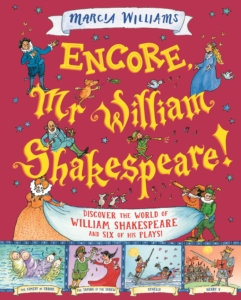Can Comic-Strips Help to Engage Young Readers with History and Biography by Marcia Williams

Can Comic-Strips Help to Engage Young Readers with History and Biography
I have always been fascinated by comic-strips, and their balance between words and pictures. Maybe it has something to do with my brother being allowed a weekly comic when we were younger, but not me. I’m not sure why this was, but it certainly did me no harm as it inspired me to write and illustrate my own comics. It fascinated me that a whole story could be unveiled just through pictures and the odd speech bubble. I would create biographical comics for my friends, or a story from history that seemed particularly relevant to their lives. I loved making the comic-strips and would often challenge myself to use as few words as possible. As I grew older, and life grew more complicated, I realised the joy of using multiple layers to help explain and embellish the main story with jokes and asides. Looking back, it was a natural progression to use this style in my books for young readers.
Although the books I write now are not for an audience of one, I still feel that I am on a very personal journey with the reader. Comic strips can draw you in, both as the reader and as the creator. They work on so many levels: my books have body text, bubble text, illustrations and often one or more ‘out of box characters’ who comment on the story, either supporting a reader’s understanding, or just engaging them with a joke. I always hope that if one part of my narrative doesn’t grab a reader maybe that other little quip will spark their interest. This makes comic-strips a particularly useful way of presenting non-fiction, which can often appear dry and unappealing to the flickering mind of a young person. The ability to give information in multiple ways can make complex subjects more accessible and relatable.
Comic-strips are not for every reader, but they have a large and devoted audience and the skills required in reading them should not be underestimated. They are brilliant for the reluctant reader, with the pictures supporting the words and building the readers confidence and enjoyment. They also encourage visual literacy for all readers, whether fluent or hesitant, which is a really important tool when we are bombarded with so much visual information. It helps young people decode the meaning of images, videos and other media. But perhaps the best thing about comic-strips is the way they inspire a young person’s own creativity. This in turn brings so many benefits, such as empathy, and communication and problem-solving skills.
Comic strips are a natural playground for young people, maybe more so than for many adults, which makes them a slightly secret and subversive world, which brings its own appeal. I love using them to explore history and biography and sharing my excitement with the reader. With luck my books will lead them to be curious about the world and the amazing people, both past and present, who inhabit it.



